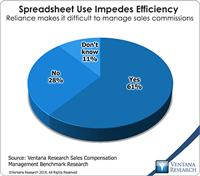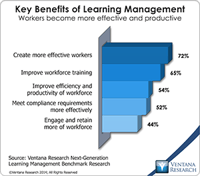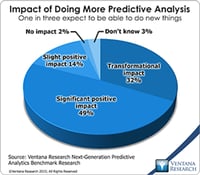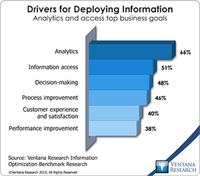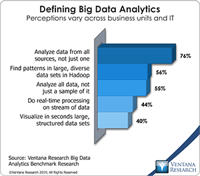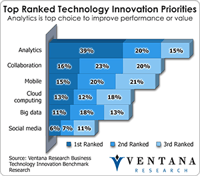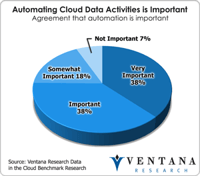I hope this title captures your attention; I’m trying to make a point about the chaos going on in managing and operating marketing. What marketing needs in 2016 is to manage and optimize its efforts in a more unified manner. This perspective kicks off a new series on the challenges for marketing to automate or execute tasks and manage toward maximum performance. We all know that the craft of marketing is in need of significant transformation, from the CMO throughout the entire marketing...
Read More
Topics:
Big Data,
Predictive Analytics,
Social Media,
Operational Performance Management (OPM),
Business Analytics,
Business Collaboration,
Business Intelligence,
Cloud Computing,
Location Intelligence,
Operational Intelligence,
Uncategorized,
Business Performance Management (BPM),
CMO,
Customer Performance Management (CPM),
Financial Performance Management (FPM),
Information Applications (IA),
Information Optimization,
Sales Performance Management (SPM)
For several years I have been advocating that sales organizations adapt their processes and applications to optimize both sales performance and the customer experience. For details see my research agenda for last year. However, it appears that not many sales organizations have responded to this challenge; many can barely maintain their quarterly sales forecasts and monthly pipeline, track progress toward quotas and ensure that sales commissions are processed promptly and paid accurately. A...
Read More
Topics:
Big Data,
Predictive Analytics,
Operational Performance Management (OPM),
Business Analytics,
Business Collaboration,
Uncategorized,
Business Performance Management (BPM),
Customer Performance Management (CPM),
Financial Performance Management (FPM),
Sales, SFA, SPM, Sales Performance Management, Sal
Businesses and their human resource organizations feel pressure to maximize the value of their human capital in today’s intensely competitive world. Many have made or considered investments in new applications that better exploit information to efficiently recruit, engage and retain the best talent. Advanced applications not only advance these processes but also help management assess the performance of the workforce and compensate individuals fairly so that they advance their careers and find...
Read More
Topics:
Big Data,
Predictive Analytics,
HCM, HR, HRMS, Workforce Management, Learning Mana,
Human Capital,
Business Analytics,
Business Collaboration,
Cloud Computing,
Governance, Risk & Compliance (GRC),
Uncategorized,
Business Performance Management (BPM),
Customer Performance Management (CPM),
Financial Performance Management (FPM),
Information Management (IM)
Technology innovation is accelerating faster than companies can keep up with. Many feel pressure to adopt new strategies that technology makes possible and find the resources required for necessary investments. In 2015 our research and analysis revealed many organizations upgrading key business applications to operate in the cloud and some enabling access to information for employees through mobile devices. Despite these steps, we find significant levels of digital disruption impacting every...
Read More
Topics:
Big Data,
Predictive Analytics,
Social Media,
Human Capital,
Operational Performance Management (OPM),
Analytics,
Business Analytics,
Business Collaboration,
Business Intelligence,
Cloud Computing,
Governance, Risk & Compliance (GRC),
Location Intelligence,
Operational Intelligence,
Uncategorized,
Business Performance Management (BPM),
Customer Performance Management (CPM),
Financial Performance Management (FPM),
Information Applications (IA),
Information Management (IM),
Sales Performance Management (SPM),
Supply Chain Performance Management (SCPM)
Data is an essential ingredient for every aspect of business, and those that use it well are likely to gain advantages over competitors that do not. Our benchmark research on information optimization reveals a variety of drivers for deploying information, most commonly analytics, information access, decision-making, process improvements and customer experience and satisfaction. To accomplish any of these purposes requires that data be prepared through a sequence of steps: accessing, searching,...
Read More
Topics:
Big Data,
Predictive Analytics,
Operational Performance Management (OPM),
Analytics,
Business Analytics,
Business Collaboration,
Business Intelligence,
Business Mobility,
Cloud Computing,
Data Preparation,
Location Intelligence,
Operational Intelligence,
Business Performance Management (BPM),
Customer Performance Management (CPM),
Financial Performance Management (FPM),
Information Applications (IA),
Information Management (IM),
Information Optimization,
IT Performance Management (ITPM),
Sales Performance Management (SPM),
Supply Chain Performance Management (SCPM),
Workforce Performance Management (WPM)
Big data has become a big deal as the technology industry has invested tens of billions of dollars to create the next generation of databases and data processing. After the accompanying flood of new categories and marketing terminology from vendors, most in the IT community are now beginning to understand the potential of big data. Ventana Research thoroughly covered the evolving state of the big data and information optimization sector in 2014 and will continue this research in 2015 and...
Read More
Topics:
Big Data,
MapR,
Predictive Analytics,
SAP,
Human Capital,
Mulesoft,
Operational Performance Management (OPM),
Paxata,
SnapLogic,
Splunk,
Business Analytics,
Business Intelligence,
Cloud Computing,
Cloudera,
Hortonworks,
IBM,
Informatica,
Information Management,
Operational Intelligence,
Oracle,
Business Performance Management (BPM),
Customer Performance Management (CPM),
Datawatch,
Dell Boomi,
Financial Performance Management (FPM),
Information Management (IM),
Information Optimization,
Sales Performance Management (SPM),
Savi,
Sumo Logic,
Supply Chain Performance Management (SCPM),
Tamr,
Trifacta,
Strata+Hadoop
Many businesses are close to being overwhelmed by the unceasing growth of data they must process and analyze to find insights that can improve their operations and results. To manage this big data they find a rapidly expanding portfolio of technology products. A significant vendor in this market is SAS Institute. I recently attended the company’s annual analyst summit, Inside Intelligence 2014 (Twitter Hashtag #SASSB). SAS reported more than $3 billion in software revenue for 2013 and is known...
Read More
Topics:
Big Data,
Predictive Analytics,
SAS,
Event Stream,
Operational Performance Management (OPM),
Analytics,
Business Analytics,
Business Intelligence,
CIO,
Data Management,
Information Management,
Location Intelligence,
Operational Intelligence,
Business Performance Management (BPM),
Customer Performance Management (CPM),
Discovery,
Information Applications (IA),
Information Management (IM)
At this year’s annual SAP user conference, SAPPHIRE, the technology giant showed advances in its cloud and in-memory computing efforts. It has completed the migration of its conventional application suite and portfolio of tools to operate on SAP HANA, its in-memory computing platform, and made improvements in its cloud computing environment, SAP HANA Enterprise Cloud. The last time I analyzed SAP HANA was when it won our firm’s 2012 Overall IT Technology Innovation Award. Now HANA has been...
Read More
Topics:
Big Data,
Predictive Analytics,
SAP,
Social Media,
Teradata,
Mobile Technology,
Operational Performance Management (OPM),
Business Analytics,
Business Collaboration,
Business Intelligence,
CIO,
Cloud Computing,
Governance, Risk & Compliance (GRC),
HP,
Business Performance Management (BPM),
CFO,
CMO,
Customer Performance Management (CPM),
Financial Performance Management (FPM),
Information Applications (IA),
Information Management (IM),
SAP EPM,
SAP HANA,
SAP Lumira,
SAPPHIRE,
Supply Chain Performance Management (SCPM),
Tagetik,
Workforce Performance Management (WPM)
I recently attended the annual SAS analyst summit to hear the latest company, product and customer growth news from the multi-billion-dollar analytics software provider. This global giant continues to grow its business and solutions to help with fraud prevention, marketing and risk. It lets users apply its analytic and statistical technology in practical applications for business. SAS can meet midsized businesses’ demand with packaging and pricing to ensure it is not seen as only affordable to...
Read More
Topics:
Big Data,
Predictive Analytics,
SAS,
Fraud,
GRC,
Operational Performance Management (OPM),
Analytics,
Business Analytics,
Business Intelligence,
CIO,
Cloud Computing,
Data Integration,
Governance, Risk & Compliance (GRC),
Information Management,
Operational Intelligence,
Business Performance Management (BPM),
Customer Performance Management (CPM),
Financial Performance Management (FPM),
Information Applications (IA),
Information Management (IM),
Risk,
Sales Performance Management (SPM)
Managing the access, storage and use of data effectively can provide businesses a competitive advantage. Last year I outlined what the big deal is in big data, as the initial focus on the volume, velocity and variety of data – what my colleague Tony Cosentino calls the three V’s – is only one small piece of how organizations should evaluate this technology. The more balanced approach is to include what he calls the three W’s – the what, so what and now what, which shifts the focus to an...
Read More
Topics:
Big Data,
Master Data Management,
Predictive Analytics,
MDM,
Business Analytics,
Business Collaboration,
Business Intelligence,
Business Mobility,
CIO,
Cloud Computing,
Data Governance,
Data Integration,
Information Management,
Location Intelligence,
Operational Intelligence,
Information Applications (IA),
Information Management (IM),
Product Information Management,
Sales Performance Management (SPM),
Workforce Performance Management (WPM)



